A History of Rome and Pluto Returns Part 2: Ancient Rome’s Pluto Returns: Governance Crisis and Barbarian Attack!
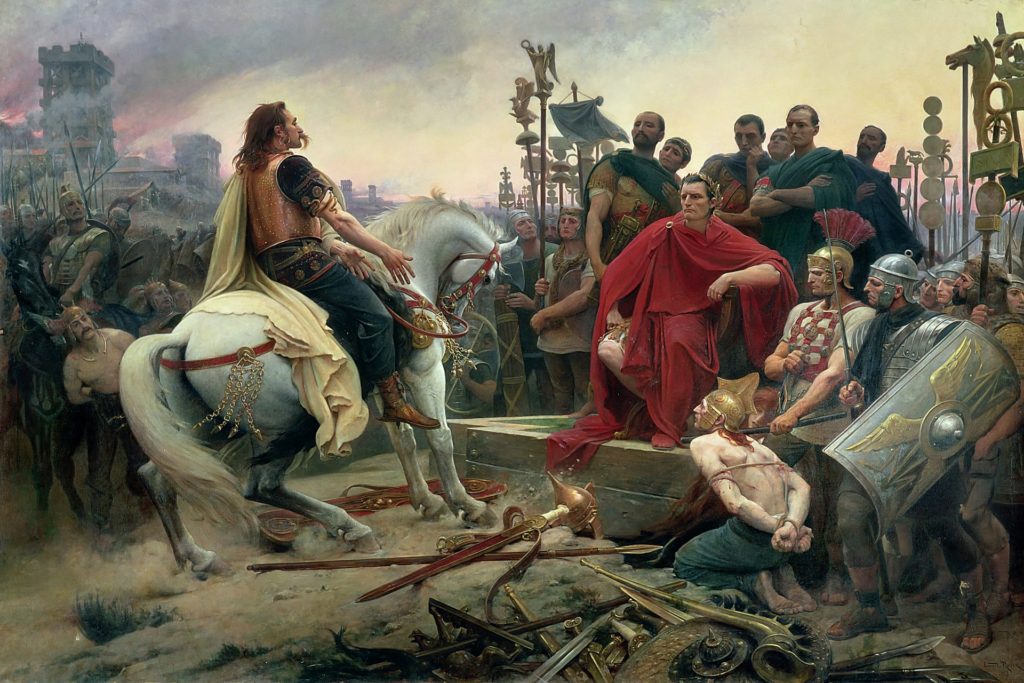
Ancient Rome had five different Pluto Returns before the Western Empire fell in 476 AD. I have listed all of them in the table below, along with some general notes for the intervening period.
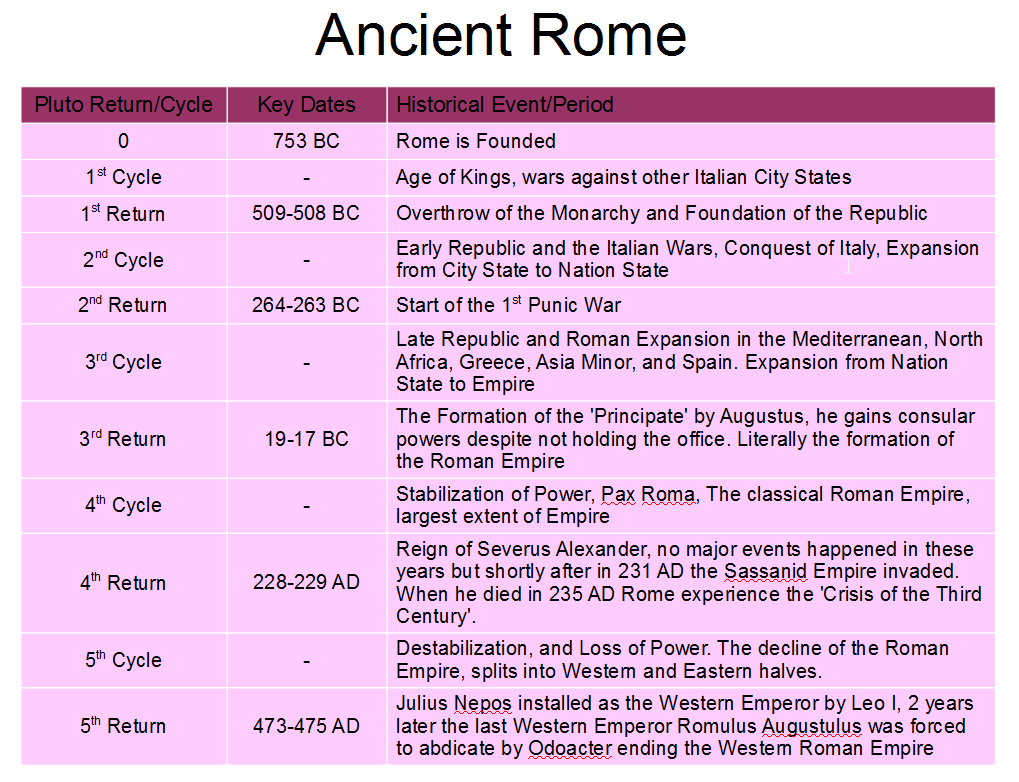
Most of the Pluto Cycle periods have a general theme on what the Pluto cycle was about. For Rome’s first Pluto Cycle, it was an age of Kings, and various wars fought against neighboring Italian city states. While most of the early Kings are considered mythological, historians do agree that during this time Rome was ruled by Kings.
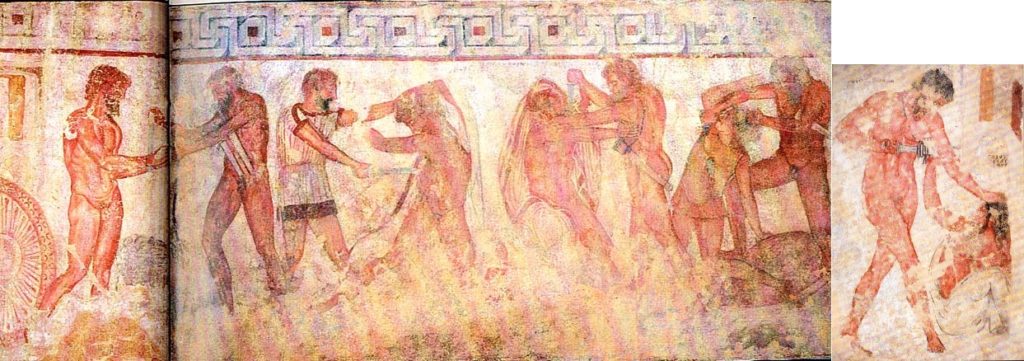
Rome’s first Pluto Return occurred in the years 509-508 BC. 509 BC and this is the traditional date for the founding of the Roman Republic by most historians. There is some debate about the exact date Rome became a republic because the old Roman Calendar kept track of years by who was consul at the time. The consul was Rome’s highest elected office and traditionally two people served a 1 year term simultaneously. Obviously, this was not best thought out of the calendar system.
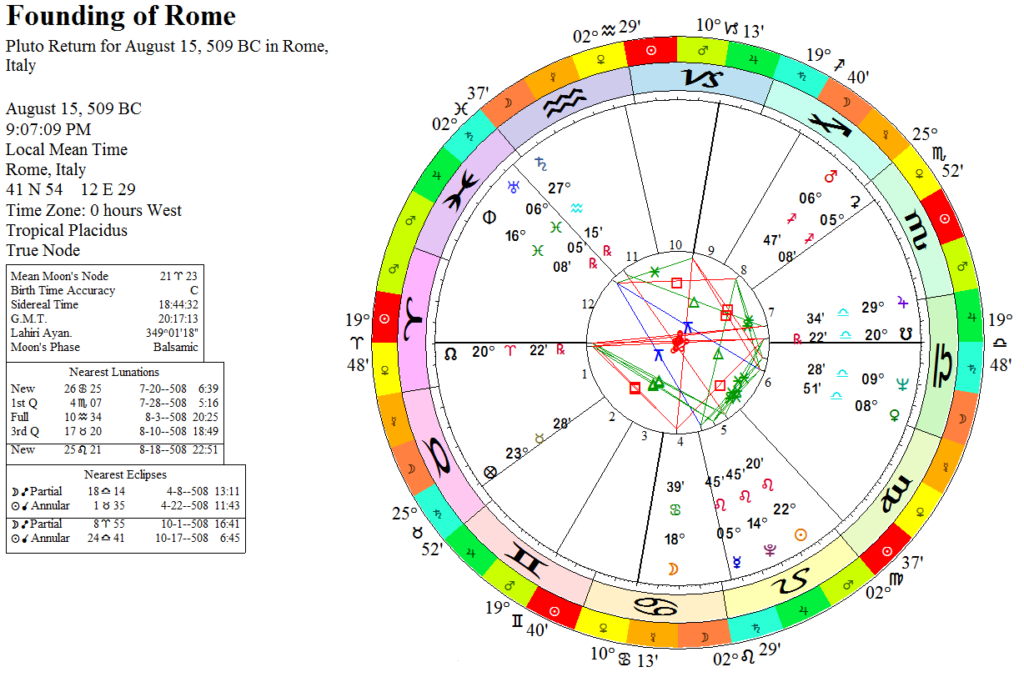
However, it is amazing to think that even working with such uncertain, mythological dates, Rome’s first Pluto Return exactly corresponds to the Foundation of the Republic. It is almost like they ‘knew’ about the Pluto Cycle without even imagining that planets beyond Saturn could exist! And as one will see, very important periods in Rome still follow this cycle even in more recent times despite the founding date being mythological.
Rome’s first Pluto Return was represented as a change in government. The planet Pluto can demonstrate its influence through transformation or change. When it manifests on the mundane scale, this can readily be apparent in a change of government. This will occur for other Pluto Returns in Rome’s history, but most of Rome’s Pluto Returns are more like the second return, an external threat against the state.
During the second Pluto Cycle, Rome embarked on various wars against other Italian city states and by the time of its second Pluto Return, Rome had conquered the entire Italian Peninsula. This Pluto Cycle was a one of expansion from city state to nation state. This immediately brought them into conflict with Carthage, the only other major regional power in the Western Mediterranean.
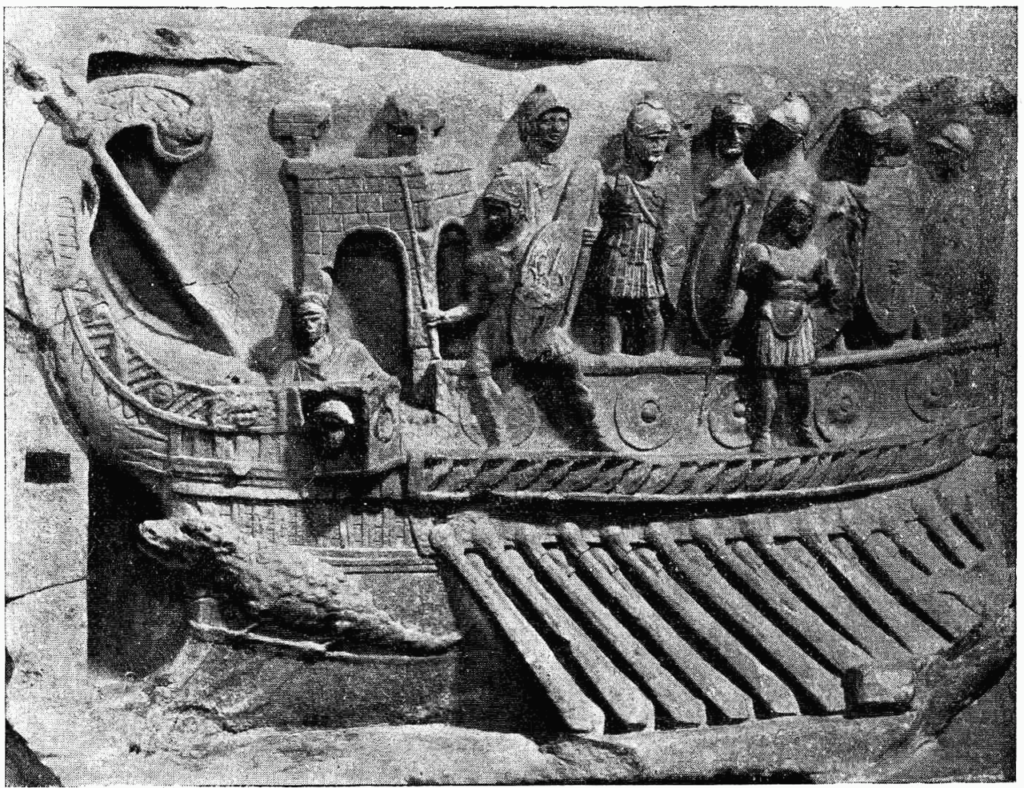
The start of the First Punic War against Carthage started in 264 BC which coincided with Rome’s second Pluto Return in 264-263 BC. While Rome was the nation that started the war, it quickly became a long and expensive fight that threatened the existence of the state. Both Rome and Carthage were extremely short of funds and manpower. It is estimated that 17% of Rome’s male population was lost in this war. Truly existence of Rome was at stake here as this type of loss is extremely rare. For instance the closes modern comparison percentage wise would be the losses the Soviet Union had in World War II.
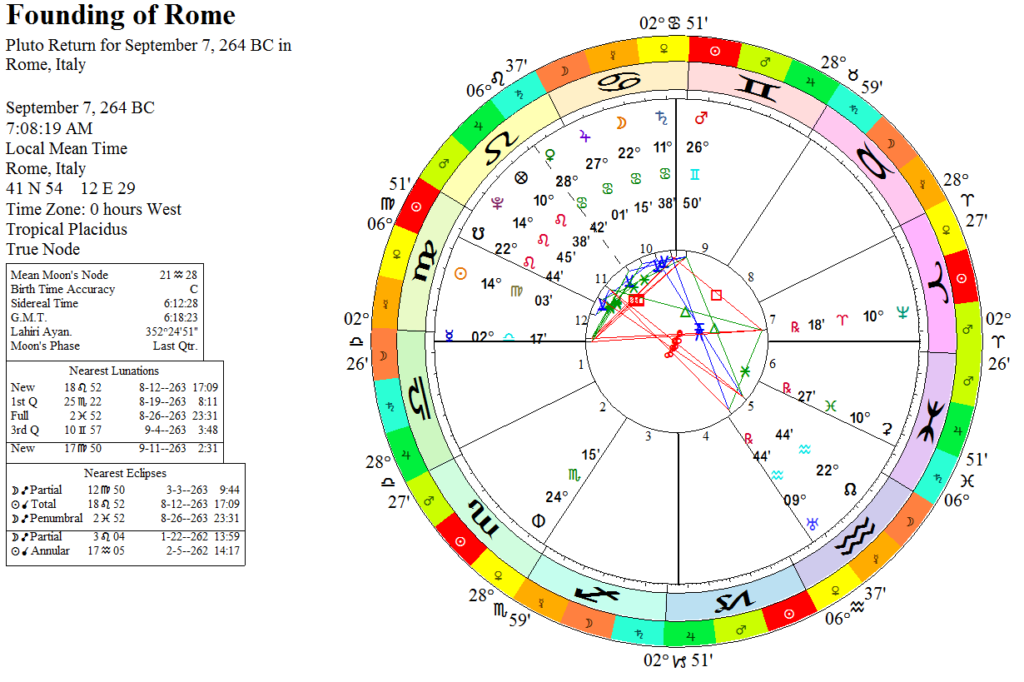
Rome won the war after years of fighting, and then began expansion across the Mediterranean. During this time they conquered North Africa (Carthage mainly), Spain, Greece, Asia Minor (now Turkey) and even expanded into Gaul (now France). This cycle represented the the expansion from nation to empire, even if it wasn’t called an empire just yet. It was during the later part of this cycle that the republican government of Rome, that defined so much of its history, started to strain under the management of it’s newly won empire.
While the Roman civil wars of Sulla, and later Caesar didn’t occur near Rome’s third Pluto Return, they did show that the existing government was completely dysfunctional towards the end of this Pluto Cycle. This period of civil wars and unrest lasted for about the last 70 years before Rome’s third Pluto Return. Caesar’s heir, Gaius Octavian, fought another civil war against Mark Anthony that marked the end of the Republic and created a new governmental system called the Principate, which is better known today as an Empire.
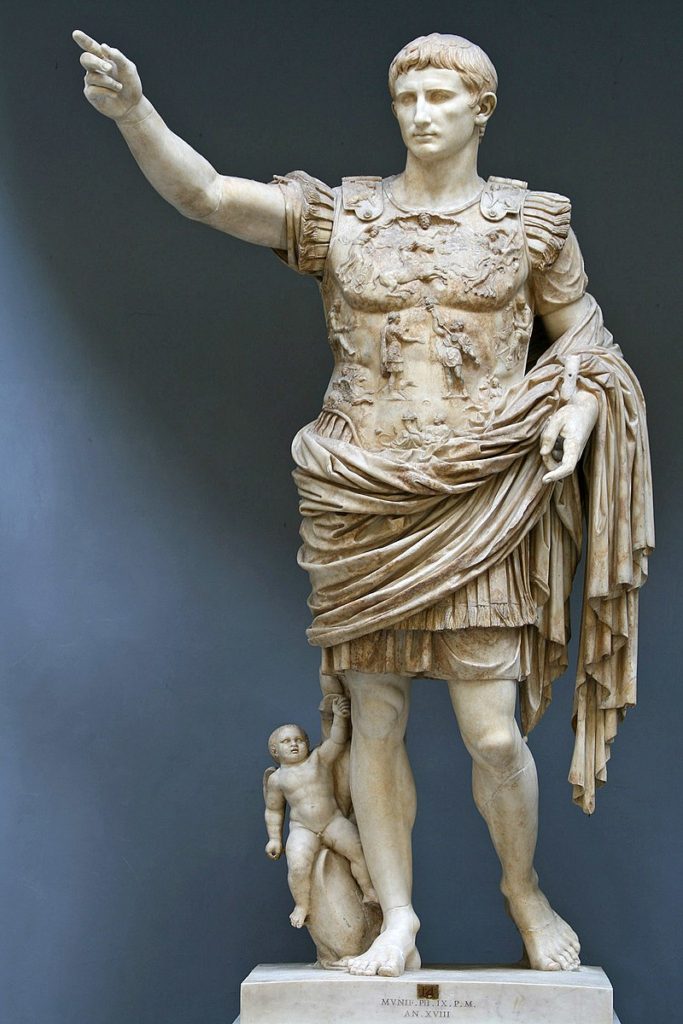
Historians don’t mark the beginning of Principate until 27 BC when the Roman Senate formally relinquished power to Octavian, who now was called Augustus. During 23 BC Augustus asked the Senate to adjust some of the terms of the power transfer. He then used this date as the official start of his reign.
The beginning of his reign neared Rome’s third Pluto Return of 19-17 BC. There is an event that did happen in 19 BC that could be used as an exact date for the completion of Augustus’ accumulation of power. That year the Senate granted him consular power without having to hold the office. Before he only had proconsular power. And with that the transfer of power from Senate to the Roman ‘Princeps‘ (Emperor) was completed and Rome had another new form of government.
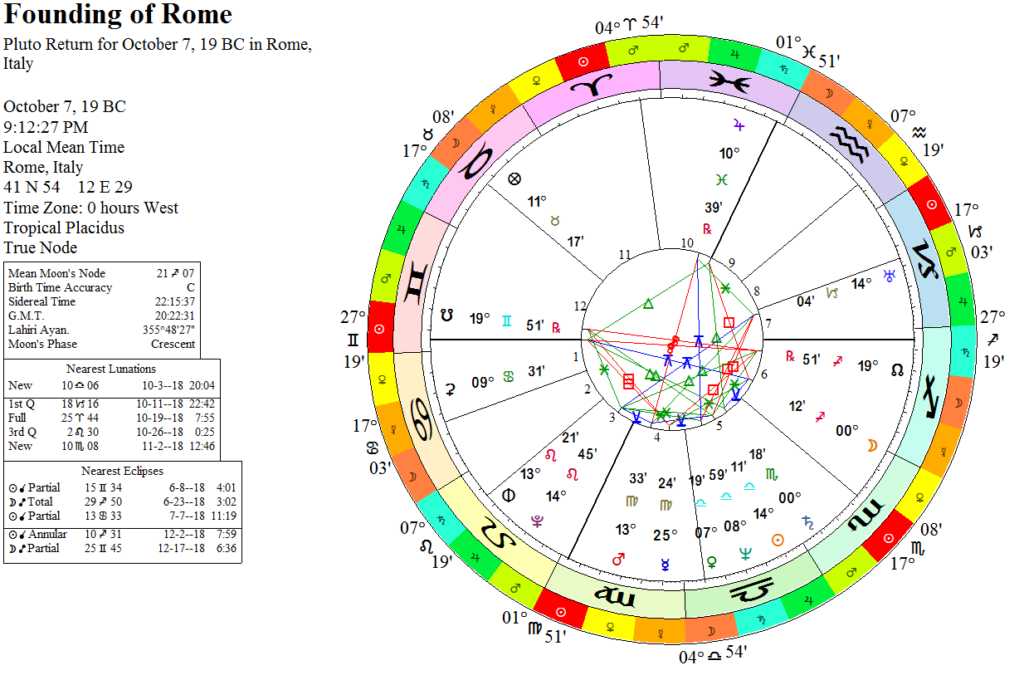
The Roman Empire during its fourth Pluto Cycle, was one of stabilization of power. This was the time the Roman Empire reached its maximum extent in terms of territory and people. It was the time of the Pax Roma (Roman Peace), where a majority of its citizens lived without fear of war, except on the border regions. Such empires are usually fleeting and by the time of it’s fourth Pluto Return, things were beginning to take a turn for the worst.
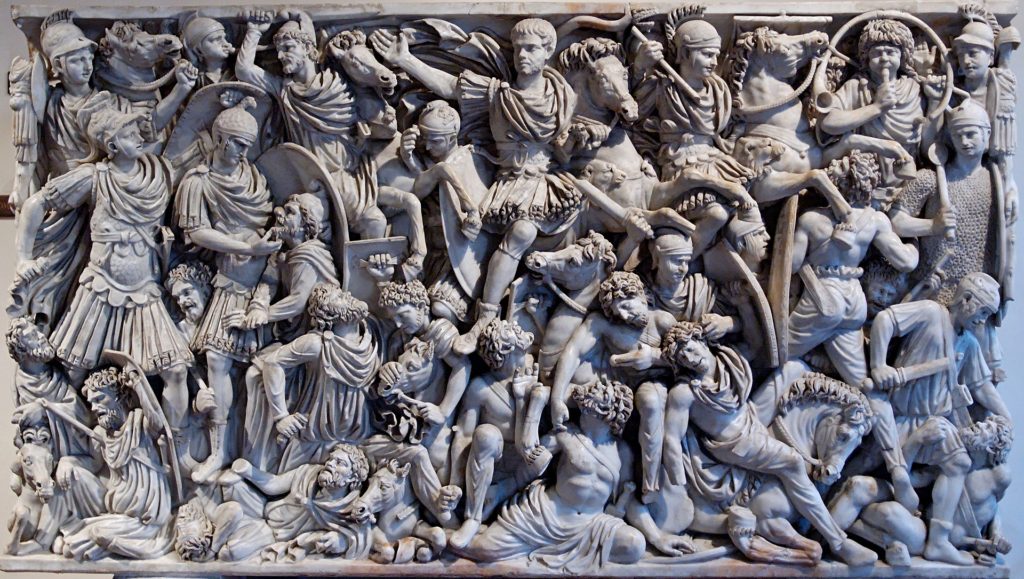
Rome’s fourth Pluto Return occurred during the reign of Severus Alexander during 228-229 AD. While nothing of importance happened during this return, shortly after in 231 AD the Sassanid Empire (Persia or modern Iran) attacked Roman provinces in the Middle East. This war did not go well for Rome as it suffered a series of major defeats. This, coupled with the Germans invasions a few years later and his death in 235 AD, lead to a 50 year period of instability and invasion by barbarians called the Crisis of Third Century.
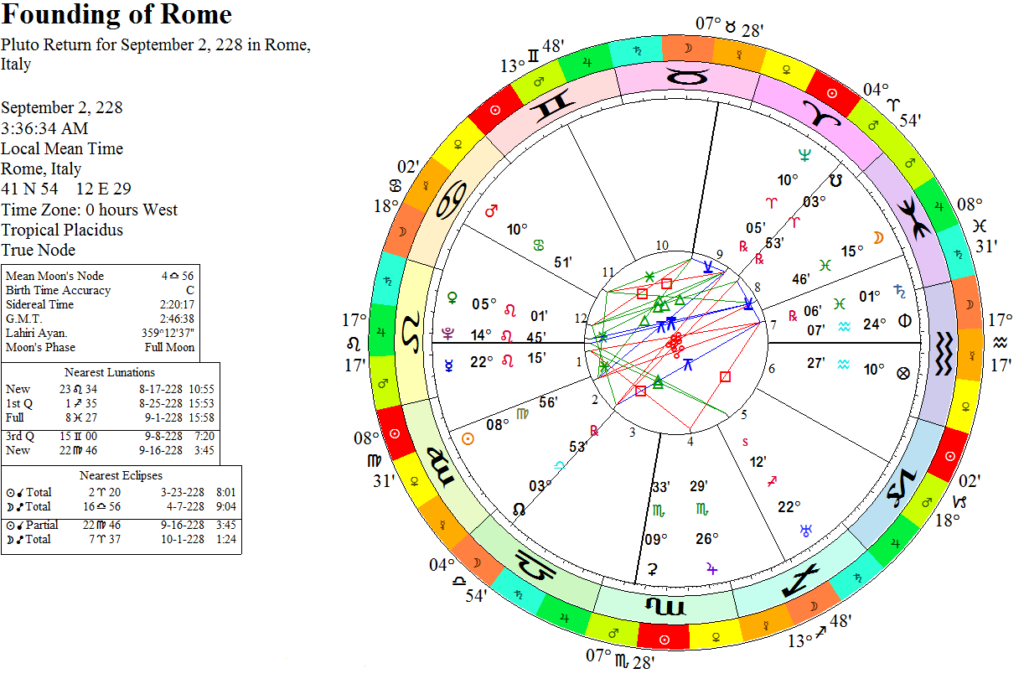
This Pluto Return signaled the beginning of the end for the empire since the Roman Empire didn’t even try to make major reforms to its government even though they were needed. This was another period where the existence of Rome was at stake. In fact during the worst part period of the Roman Empire it was split into three different empires in competition with one another. And the only reason any of them didn’t try to invade and conquer each other was the fact they were too busy individually fighting barbarians or the Sassanid Empire to bother.
After the Crisis of the Third Century, the Roman Empire really began to decline despite some Emperors being able to stabilize it from time to time. The fifth Pluto Cycle was one of destabilization and loss of power. The Roman Empire was often divided between two emperors. One ruled the Western Roman Empire, while the other ruled the Eastern Roman Empire. Most of this time Rome was under the constant threat of barbarian invasion from Germanic tribes and each of the Empire rarely cooperated with other.
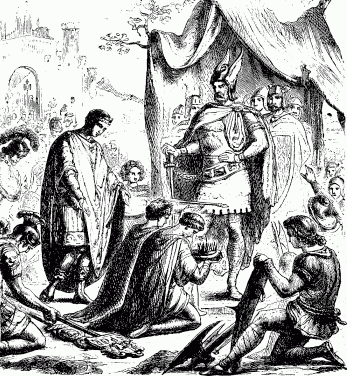
Rome’s fifth Pluto Return occurred in 473-475 AD. This corresponds quite nicely with the accepted historical date for the Fall of the Western Roman Empire of 476 AD. The last Western Roman Emperor, Romulus Augustulus was forced to abdicate when Odoacter invaded Italy and established himself as the King of Italy.
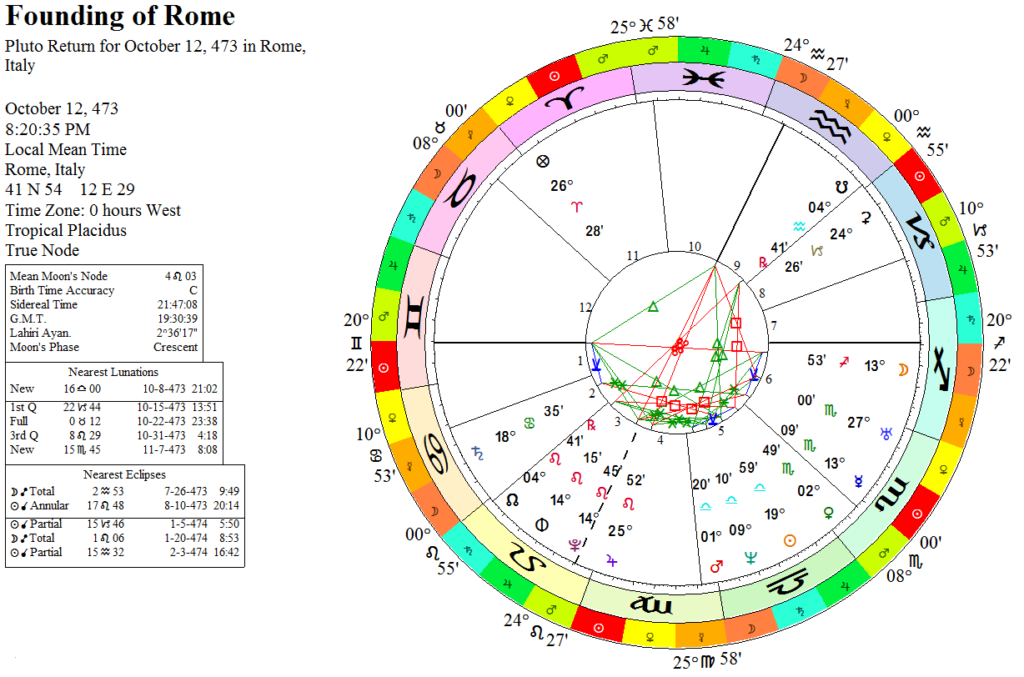
Ancient Rome had two major changes of government during its first five Pluto Return. There were three external crises that threatened the existence of the nation or empire and the last one actually did destroy it. The threat of an external government of factor is the main result of the a Pluto Return for Rome.
Astrologically, this probably ties in the Neptune Pluto cycle. Both planets are in resonance orbit with each other. So Neptune will be in one of two different signs every other Pluto Return. In Rome’s chart this is either at 10 degrees Aries or Libra. When in Aries, often the threat of war and foreign invasion was a hand. When in Libra, a change in government was imminent.

One of the changes in governments corresponds to the rise of an autocratic ruler, Augustus. This is the third general meaning for a Pluto Return. Besides the crisis period, in the later history of Rome, a few times a strong autocratic ruler appears during the Pluto Return and nothing major really happens.
Astrologically, the autocratic ruler may be tied to an aspect with the Sun. In the 19 BC Return, Pluto makes a partile sextile to the Sun. And amazingly this sextile aspect is also present in the the 473 AD chart, which is at the time of the the last Roman Emperor in the West.
Articles in this Series:
Rome’s Founding Mythical Chart
Byzantium Rome’s Pluto Returns: Invaders at the Gates!
Medieval Rome’s Pluto Returns: Religious Reform within While Chaos is Outside
Modern Rome’s Pluto Returns: Let’s Try this Again!
Implication’s for New Rome’s, America’s, First Pluto Return
Related Posts

A History of Rome and Pluto Returns Part 5: Modern Rome’s Pluto Returns: Let’s Try this Again!

A History of Rome and Pluto Returns Part 6: Implication’s for New Rome’s, America’s, First Pluto Return
